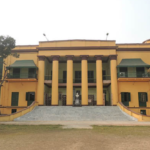The history of Uttarpara dates back to 1704 AD when Shri Ratenswar Roychowdhury, a zamindar from the famous Sabarnya Chowdhury clan, relocated from his ancestral village near Barrackpur in the 24 Parganas district to a new settlement on the banks of the Hooghly River, known as Ootarpara. At that time, Ootarpara was the northern part of the village Bally, which was part of the Sheorafully Zamindary. The name “Ootarpara” literally means “Northern Part” in Bengali. Ratenswar exchanged his ancestral property for Ootarpara and moved there with his family and followers.

Back then, Ootarpara was a marshland with sparse human settlement. The area was primarily inhabited by fishermen from the Patni and Malo castes, and a few Muslims, who were involved in fishing, marketing fishing equipment, ferry services, and even dacoity.
The Kaulinya System and Early Settlers
As a Brahmin, Ratenswar was compelled by the Kaulinya system to bring other Brahmin families to the area for matrimonial alliances. Gradually, several Brahmin families, including those of Durga Charan Banerjee, Ramtanu Chatterjee, Ramnidhi Chatterjee, and Nandalal Mukherjee, migrated to Ootarpara through matrimonial relations with Ratenswar’s descendants. These families played a crucial role in the intellectual and spiritual development of Uttarpara. Over time, the name “Ootarpara” evolved into the more refined “Uttarpara.”

Growth and Development (1800-1900)
Between 1800 and 1900, the tiny village of Uttarpara transformed into a small town covering an area of 0.8 square miles. Key figures like Ramhari Roy, the great-grandson of Ratenswar, Joykrishna Mukherjee, and Rajkrishna Mukherjee, grandson of Nandalal Mukherjee, were instrumental in this transformation. They led the construction of palatial buildings, broad roads, a modern sanitary system, tension bridges across Bally Khal, hospitals, schools, a municipality, a public library, a police station, a post office, and the Uttarpara Railway Station. The residents of present-day Uttarpara continue to benefit from the solid foundation laid during this period. Here’s more on history of Uttarpara

Notable Visitors
During this period, Uttarpara attracted several distinguished visitors, including Sir Arthur Wellesley (Duke of Wellington), John Lawrence, Lord Canning, and prominent Indian personalities such as Ishwar Chandra Vidyasagar, Sir Surendra Nath Banerjee, Keshab Sen, Swami Vivekananda, Sri Aurobindo, and Netaji Subhas Chandra Bose.
The Independence Struggle (1900-1947)
Uttarpara and its illustrious sons played a significant role in the struggle for India’s independence between 1900 and 1947. The youth here responded enthusiastically to both Gandhi’s call for non-violence and Surya Sen’s armed struggle. Revolutionaries like Dhrubesh Chattopadhyay, Amarendra Nath Chattopadhyay, Chaitanya Deb Chattopadhyay, and many others sacrificed their lives in the Cellular Jail in the Andamans. Shaheed Smritish Bandopadhyay lost his life while preaching Gandhi’s message of non-violence during the Hindu-Muslim riots of 1947.
Administrative Changes and Infrastructure
Until 1843, it was part of the 24 Parganas district, under the jurisdiction of Baidybati Police Station. In 1795, Hooghly District was carved out of Burdwan District. Baidybati Police Station became part of Hooghly District in 1814, bringing Uttarpara under Hooghly District. Baidybati Police Station was later included in Serampore Police Station. In 1916, Uttarpara got its own police station. The geographical coordinates of Uttarpara are 22 degrees 40 minutes north latitude and 88 degrees 22 minutes longitude.
To facilitate easier communication with Kolkata and relieve the hazardous boat journeys, a tension bridge was constructed, ending the boat ferry service from here to Bally. This bridge was formally opened to the public on February 14, 1846.

Educational and Medical Advancements
The first rays of the Bengali Renaissance enlightened Uttarpara. Visionaries like Joykrishna Mukherjee and his brother Rajkrishna recognized the value of modern education and appealed to the British for an English school in Uttarpara. Joykrishna offered one of his palatial buildings and financial aid for setting up the school. The local community also contributed funds. The school, which opened on May 15, 1846, with Mr. Robert Hord as its first headmaster, later became known as Uttarpara Government High School, with Sri Ramtanu Lahiri serving as a notable headmaster from 1852 to 1856.

In 1848-49, Joykrishna and Rajkrishna approached the government to establish a modern hospital. True to their spirit, Joykrishna donated one of his buildings that generated an annual income of Rs. 1800 for the hospital. The hospital started operations in May 1851, with Sub-Assistant Surgeon Dr. Dayalchand Basak as its first in-charge.
Formation of Uttarpara Municipality
The Municipality was formed on April 14, 1853, marking a significant milestone in the administrative development of the town.
Conclusion
Uttarpara’s journey from a marshland to a vibrant town is a testament to the vision and dedication of its early settlers and leaders. The town’s rich history is marked by significant contributions to education, health, infrastructure, and India’s independence movement. The legacy of Uttarpara’s past continues to shape its present, making it a place of historical and cultural significance in West Bengal.
More Information: Uttarpara Municipality Website




